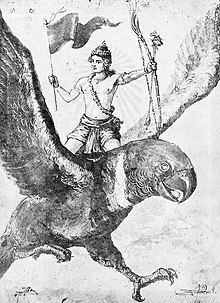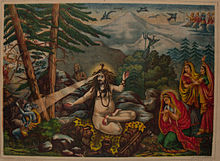Kamadeva
| Kamadeva | |
|---|---|
God of Love, Desire, Pleasure and Beauty | |
Harivamsha, Puranas | |
| Gender | Male |
| Personal information | |
| Parents | Brahma (father)[a] |
| Consort | Rati[b] |
| Children | Harsha and Yasha (sons) |
| Equivalents | |
| Greek equivalent | Eros[6] |
| Roman equivalent | Cupid[5] |
Kama (
The
Etymology and other names
The name Kama-deva (
Other names prominently used about Kamadeva are:
- Kama (काम) - desire; longing.[2]
- Manmatha (मन्मथ) - one who agitates mind.[2][5]
- Madana (मदन) - one who intoxicates with love.[2][5][10][12]
- Mara (मार) - he who wounds.[2][5]
- Ananga (अनंग) - he who is without a body.[2][5]
- Kushumeshara (कुसुमशर) he whose arrows are flowers.[2][5]
- Pradyumna (प्रद्युम्न) - he who conquers all. It is also the named of Kama's reincarnation.[2][5]
- Kandarpa (कन्दर्प) or Darpaka (दर्पक) - the inflamer. Brahma gave him this name.[2][13]
- Manasija (मनसिज) , Manoja (मनोज) and Bhavaja (भवज) - he who is born of mind.[13][2]
- Ratikanta (रतिकांत) or Ratipati (रतिपति)- husband of Rati.[2]
- Abhirupa (अभिरूप) - the beautiful one. Also a name for both Vishnu and Shiva.[14]
Iconography
Kāmadeva is represented as a young, handsome man who wields a
Some of the attributes of Kamadeva are: his companions are a cuckoo, a parrot, humming bees, the season of spring, and the gentle breeze.[5] All these are symbols of the spring season when his festival is celebrated as Holi, Holika, or Vasanta.[citation needed]
Textual sources
Images and stories about the Hindu god Kamadeva are traced to the verses of the
Kamadeva is also mentioned in the 12th-century Javanese poem Smaradahana, a rendering of the myth of Kamadeva's burning by Shiva and fall from heaven to earth. Kama and his consort Rati are referenced as Kamajaya and Kamarati in Kakawin poetry and later Wayang narratives.[citation needed]
Legends
Birth

The story of the birth of Kamadeva has several variants in different Hindu scriptures.[18]
In the
According to
In some traditions, Kama is considered a son of the goddess of wealth Lakshmi, and the preserver god Vishnu due to his birth as Pradyumna to Rukmini and Krishna, the incarnations of Lakshmi and Vishnu respectively.[5][26][4] According to Matsya Purana, Visnu-Krishna and Kamadeva have a historical relationship.[16]
Family and assistants
Both the epics and the
In most scriptures, Kama and Rati have two children, Harsha ("Joy") and Yashas ("Grace"). However, the Vishnu Purana mentions that they only have one son – Harsha.[3]
Besides Rati, Kama's main assistant is Vasanta, the god of spring season, who was created by Brahma. Kama is served by a group of violent
Incineration by Shiva

One of the principal myths regarding Kama is the legend of his incineration by Shiva, called the Madana-bhasma, also rendered the Kama dahana. It occurs in its most developed form in the Matsya Purana (verses 227–255),[31] but is also repeated with variants in the Shiva Purana and other Puranas.[32]
In the narrative,
After he awakens Shiva with a flower arrow, Shiva, furious, opens his third eye, which incinerates Kamadeva instantaneously, turning him into ash. Shiva observes Parvati before him. Impressed by her ascetic practice, he allows her to choose a boon of her choice. She enjoins him to restore Kamadeva to life. Shiva agrees to let Kamadeva live, but in a disembodied form, travelling like the wind with his bow and arrow with his consort, Rati. Shiva and Parvati's marriage results in the birth of a son, Kartikeya, who goes on to defeat Taraka.[33]
Incarnations
According to
Beliefs and worship
The deity of Kamadeva along with his consort Rati is included in the pantheon of Vedic-Brahmanical deities such as
The religious rituals addressed to him offer a means of purification and re-entry into the community. Devotion to Kamadeva keeps desire within the framework of the religious tradition.[37] Kamadeva appears in many stories and becomes the object of devotional rituals for those seeking health, and physical beauty, husbands, wives, and sons. In one story[where?] Kamadeva himself succumbs to desire, and must then worship his lover to be released from this passion and its curse.
Rituals and festivals

Holi is a Hindu festival, celebrated in the Indian subcontinent. It is sometimes called Madana-Mahotsava[38] or Kama-Mahotsava.[39][40] This festival is mentioned by Jaimini, in his early writings such as Purvamimamsa-sutra, dated c. 400 BC.[39]
The Ashoka tree is often planted near temples. The tree is said to be a symbol of love and is dedicated to Kamadeva.[41]
In the
The Kamadeva that was incinerated is believed to be a celestial
When Kamadeva is referenced as smara in Bhāgavata Purāṇa (book 10) in the context of the supramundane love between Krishna and the
Temples
While it is believed that there are no temples to Kamadeva, and no murtis (statues) of Kamadeva are sold for worship on the market,[48] yet there is an ancient temple of Madan Kamdev in Baihata Chariali, Kamrup district in Assam. Madan is the brother of Kamadeva. The ruins of Madan Kamdev are scattered widely in a secluded place, covering 500 meters.
Some other temples dedicated or related to this deva:
- Kameshwara Temple, in Sthala purana indicates that Kamadeva woke up Shivaat this place.
- Kameshvara Temple, in Vrindavana.[49]
- Soundaraja Perumal Temple at Thadikombu, near Dindigul, Tamil Nadu[50]
- Harsat-Mata Temple at Abhaneri has a representation of Kamadeva.[51]
In English literature
Letitia Elizabeth Landon's descriptive poem Manmadin, the Indian Cupid, floating down the Ganges appeared in The Literary Gazette, 1822 (Fragment in Rhyme VII.)
Notes
- ^ In some scriptures, Kama has a second consort named Priti.[4]
- ^ Distinct from the consort of Vishnu who has the same name.
- ^ In the Kalika Purana, Kama also shoots at the prajapatis, and later from the sweat of Daksha, Rati emerges.[2]
- ^ In some versions, the role of Dharma is absent. Instead, Shiva sees them while traveling there.[24]
- ^ In some texts like the Matsya Purana and Brahmanda Purana, a different name is used for Sandhya.[24][13][2]
- ^ In this version, Kama is cursed by Brahma as he initially ignores his orders.[24]
References
- ^ Kāṇe, Pāṇḍuraṅga Vāmana; Institute, Bhandarkar Oriental Research (1958). History of Dharmaśāstra.
- ^ ISBN 978-8120805972.
- ^ a b c Hopkins, Edward Washburn (1915). Epic mythology. Robarts - University of Toronto. Strassburg K.J. Trübner.
- ^ ISBN 9788176250399– via Google Books.
- ^ a b c d e f g h i j "Hindu Mythology, Vedic and Puranic: Chapter V. The Incarnations or Avatāras of Vishnu: Kamadeva". www.sacred-texts.com. Retrieved 2023-01-30.
- ^ James Lochtefeld (2002), The Illustrated Encyclopedia of Hinduism, Volume 1, Rosen Publishing, New York, ISBN 0-8239-2287-1, page 340
- .
- ISBN 978-1-134-27941-8.
- ISBN 978-0-19-536922-9.
- ^ a b Monier-Williams Sanskrit-English Dictionary
- ^ "Atharva Veda: Book 6: Hymn 36: In praise of Agni Vaisvānara". www.sacred-texts.com. Retrieved 2022-02-15.
- JSTOR 288995.
- ^ ISBN 978-0-691-01930-7.
- ^ Gopal, Madan (1990). K.S. Gautam (ed.). India through the ages. Publication Division, Ministry of Information and Broadcasting, Government of India. p. 61.
- ^ a b "A study of Kamadeva in Indian story literature". Columbia Educational Journal. Archived from the original on January 14, 2009. Retrieved 2008-07-06.
- ^ .
- ISBN 81-7017-278-0.
- ^ Benton 2006, p. 23
- ^ Adi Parva, Chapter 66, Verses 31-33
- ^ ISBN 9788184752779. Entry: "Kama"
- ISBN 978-81-7755-874-6.
- ^ Benton 2006, p. 36
- ^ Benton 2006, p. 44
- ^ ISBN 978-81-7020-998-0.
- ^ Benton 2006
- ^ The Book of Hindu Imagery: Gods, Manifestations and Their Meaning By Eva Rudy Jansen p. 93
- ^ Benton 2006, p. 32
- ^ Benton 2006, p. 31
- ^ Benton 2006, p. 33
- ^ Benton 2006, p. 34
- ISBN 978-0-674-78865-7., p.58
- ^ Klaus Klostermaier, (2000) Hinduism: A Short History. Oxford: One World Publications.
- Wendy Doniger O'Flaherty, (1975) Hindu Myths: A Sourcebook Translated from the Sanskrit. London: Penguin Books, p.157-159 [1]
- ISBN 9788120838819.
Kama, the presiding deity of the disc was born as Sudarsana. Sâmba the son of lord Krsna was also the incarnation of Kāma. Skanda, the son of Rudra (Shiva) was also Kåma. Since he overcame the enemies he is called Skanda. Since he overcame enemies he is called Skanda. Sudarsana, Pradyumna, Bharata, Samba, Sanatkumara, and Skanda these six are the incarnations of Kama.
- S2CID 162304052. Retrieved 2008-07-06.
- ^ Arnold, A.J. (1996). Monsters, Tricksters, and Sacred Cows: Animal Tales and American Identities. University of Virginia Press. p. 186.
- ^ Benton 2006, p. 84
- ISBN 9789350573587.
- ^ ISBN 9781576070895.
- ISBN 9788170172215.
Madana Mahotsava or Kama Mahotsava, Vasant Mahotsava are sophisticated forms of some ancient festivals. The 8th century poet ... The colourful festival of Holi has its origin in these festivals, known for their gay abandon. It is an ancient ...
- . Retrieved 2008-07-13.
- Kṛṣṇa, the Supreme Personality of Godhead. p. Ch. 55: Shaba was Born to Kṛṣṇa and Jambabati.
- ^ ISBN 978-963-03-7649-5.
- ^ vṛndāvane aprākṛta navīna madana, kāma-gāyatrī kāma-bīje yāṅra upāsana (Caitanya Caritamrita, 2.8.138)
- S2CID 161486286.
- ^ Bhagavata Purana 10.21.3 Tika, “caksu-ragah prathamam cittasangas tata ‘tha sankalpah nidra-cchedas tanuta visaya-nivrittis trapanasah / unmado muriccha mrtir ity etah smara-dasa dasaiva syuh.”
- ISBN 978-0-7914-6415-1.
Radha is without equal in the universe for beauty, and her power constantly defeats the god of love, Kamadeva.
- ^ Benton, C. (2005).
{{cite book}}: Missing or empty|title=(help) - ^ "Braj Mandala Parikrama in Mathura". www.agraindia.org.uk. Retrieved 2008-07-13.
- ^ "Temple for Cupid, Thadikombu, Dindigul". Archived from the original on 2015-04-05.
- JSTOR 3249750.
K. Deva suggests it is Kamadeva in the EITA
- Benton, Catherine (2006). God of desire: tales of Kamadeva in Sanskrit story literature. Albany, New York: State University of New York Press. ISBN 978-0-7914-6565-3.
External links
 Media related to Kamadeva at Wikimedia Commons
Media related to Kamadeva at Wikimedia Commons

